A remarkable series of meteorites in Sri Lanka containing extraterrestrial life confirm the Hoyle-Wickramasinghe
cometary panspermia hypothesis and the observational beginnings of Astrobiology and Astropaleontology. Life
and water oceans at 2 Myr could not possibly have developed by Old Cosmology with its >400 Myr of dark ages.
These first cometary panspermia observations suggest the dark matter planets of New (HGD) Cosmology. A new scenario
for star formation from merging planets (not just gas and dust) is required. The Hertzsprung-Russell diagram changes.
Large luminosity and high temperatures are no longer interpreted as due to large mass stars, but to large rates of planet
accretion. Rapid planet accretion rates mix away the carbon cores of white dwarf stars permitting elements up to iron and
nickel to form, with neutron stars and supernovae class II. The complexity of RNA-DNA requires the deep hot water
oceans and early cosmic mixing mechanisms provided by cometary panspermia and the biological big bang. See: eg
I. ASTROBIOLOGY
1. INCIDENCE OF LOW DENSITY METEOROIDS OF THE POLONNARUWA-TYPE, N. C. Wickramasinghe, J. Wallis, D.H. Wallis, M.K. Wallis, N. Miyake, S.G. Coulson, Carl H. Gibson, J.T. Wickramasinghe, A. Samaranayake, K. Wickramarathne and Richard B. Hoover, pp 9995-10003
2. THE POLONNARUWA METEORITE: OXYGEN ISOTOPE, CRYSTALLINE AND BIOLOGICAL COMPOSITION, Jamie Wallis, Nori Miyake, Richard B. Hoover, Anthony Oldroyd, Daryl H. Wallis, Anil Samaranayake, K. Wickramarathne, M.K. Wallis, Carl H. Gibson and N. C. Wickramasinghe, pp 10004-10011
Commentary by Journal of Cosmology Editor-in-Chief Rudy Schild about criticisms of this paper by "Bad Astronomer" Phil Plait, pp 10025-10042.
3. Fluid Mechanics Explains Cosmology, DarkMatter, Dark Energy, and Life, Carl H. Gibson, pp 10012-10024
This invited paper for the Minoru Freund Memorial Symposium at NASA-AMES has been criticised by NASA Referees that have not seen the above papers, which conclusively confirm the Hoyle-Wickramasinghe Cometary Panspermia hypothesis. Cometary Panspermia should now be considered an observational fact. Cometary Panspermia adds to the evidence verifying the Gibson-Schild 1996 HGD cosmology, and therefore further refutes LCDMHC cosmology. See memos of March 11 and March 19 from the NASA Editors of the Symposium Proceedings, and a highlighted version of Chapter 22 of the second edition of Professor Wickramasinghe's book that chronicles the development of cometary panspermia (CHG).
4. Discovery of Uranium in Outer Coat of Sri Lankan Red Rain Cells, Nori Miyake, Takafumi Matsui, Jamie Wallis, Daryl H. Wallis, Anil Samaranayake, Keerthi Wickramarathne and N. Chandra Wickramasinghe. pp 10042-10050
The uranium coating appears to be difficult to explain or reproduce, but the lack of phosphorus finding in red rain samples persists (CHG from NCW).
5. RED RAIN CELLS RECOVERED FROM INTERIOR OF THE POLONNARUWA METEORITE, K. Wickramarathne and N. C. Wickramasinghe, pp 10075-10079
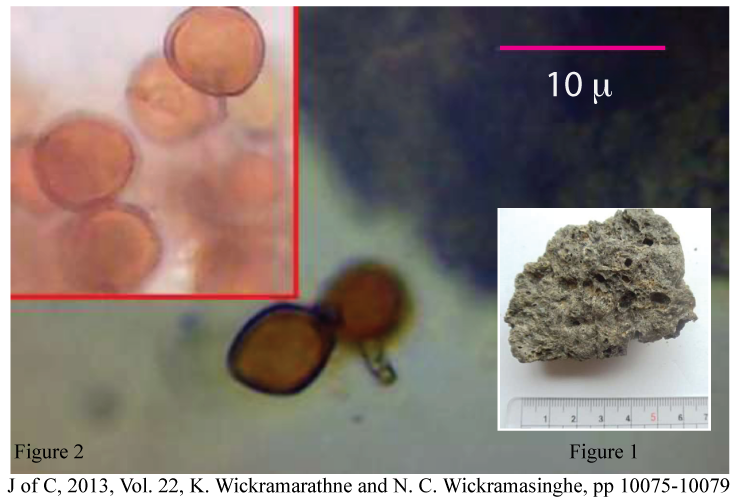
Figure JC2013.22.5.1 (CHG) Red rain cells reproducing by a 0.5 micron extrusion from a 5 micron cell in the laboratory, pp 9955-9957. The cells are shown from Fig. 2 (upper left), and the meteorite from Fig. 1.
Conclusion: Cometary panspermia is an observational fact (CHG).
6. Perihelion precession, polar ice and global warming, Duncan Steel, pp 10106-10129
7. Life begins on primordial dark matter planets, Carl H. Gibson, pp 10130-10140 (preprint of invited paper for Life)
8. Why are so many primitive stars observed in the Galaxy halo?, Carl H. Gibson, Theo M. Nieuwenhuizen, Rudolph E. Schild, pp 10163-10182 (astro-ph 1206.1287).
II. GENERAL COSMOLOGY
9. STRING COSMOLOGY IN CYLINDRICALLY SYMMETRIC SPACE-TIME WITH STIFF FLUID AND PETROV TYPE I DEGENERATE , Raj Bali, pp 10051-10074
10. ADIABATIC TRANSFORMATION OF GRAVITATIONAL STABILIZATION WAVES OF THE CRYSTALLINE VACUUM SPACE INTO BARYONS AT THE BIG BANG. J. A. Montemayor-Aldrete, J. R. Morones-Ibarra, A. Morales-Mori, P.Ugalde-Velez , A. Mendoza-Allende, E. Cabrera-Bravo and A. Montemayor-Varela, pp.10075-10105
11. TYPICAL METEORITIC WORM-LIKE FORMS SEEN IN THE POLONNARUWA METEORITE, Milton Wainwright, Christopher E. Rose, Alexander J. Baker, Briston, K.J. and N.Chandra Wickramasinghe, pp 10152-10157
12. May Turbulence and Fossil Turbulence Lead to Life in the Universe?, C.H. Gibson, Proceedings: Turbulent Mixing and Beyond 2011, ICTP, Trieste, Italy, Preprint of Physica Scripta Special Issue, pp 10158-10162
13. ISOLATION OF A DIATOM FRUSTULE FRAGMENT FROM THE LOWER STRATOSPHERE (22-27Km)-EVIDENCE FOR A COSMIC ORIGIN, Milton Wainwright, Christopher E. Rose, Alexander J. Baker, Briston, K.J and N. Chandra Wickramasinghe, pp 10183-10188, Ubiquity Press version.
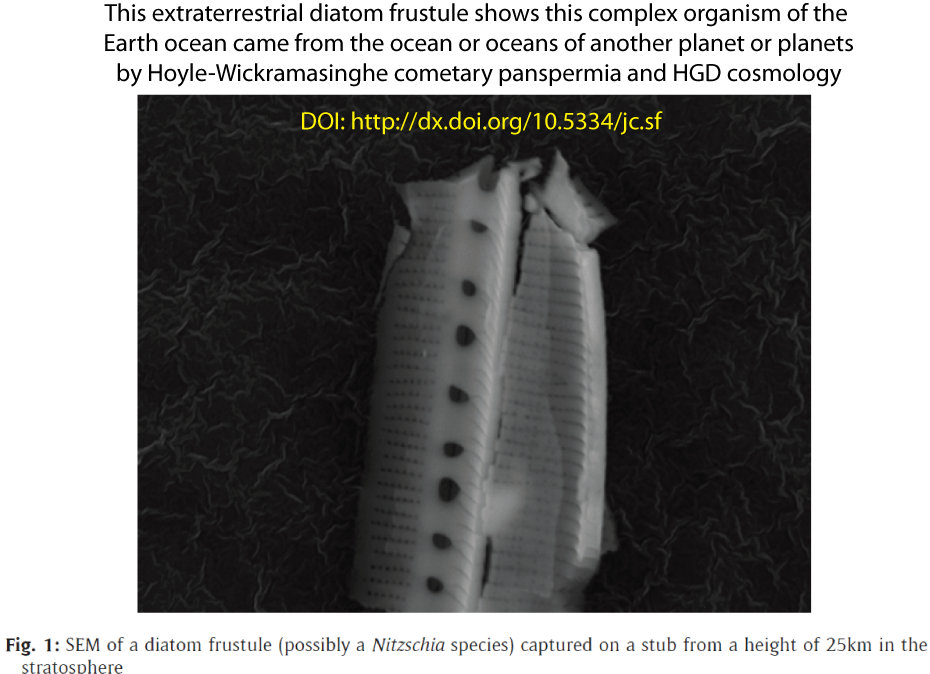
14. ISOLATION OF BIOLOGICAL ENTITIES FROM THE STRATOSPHERE (22-27Km), Milton Wainwright, Christopher E. Rose, Alexander J. Baker and N. Chandra Wickramasinghe, pp 10189-10197, Ubiquity Press version.
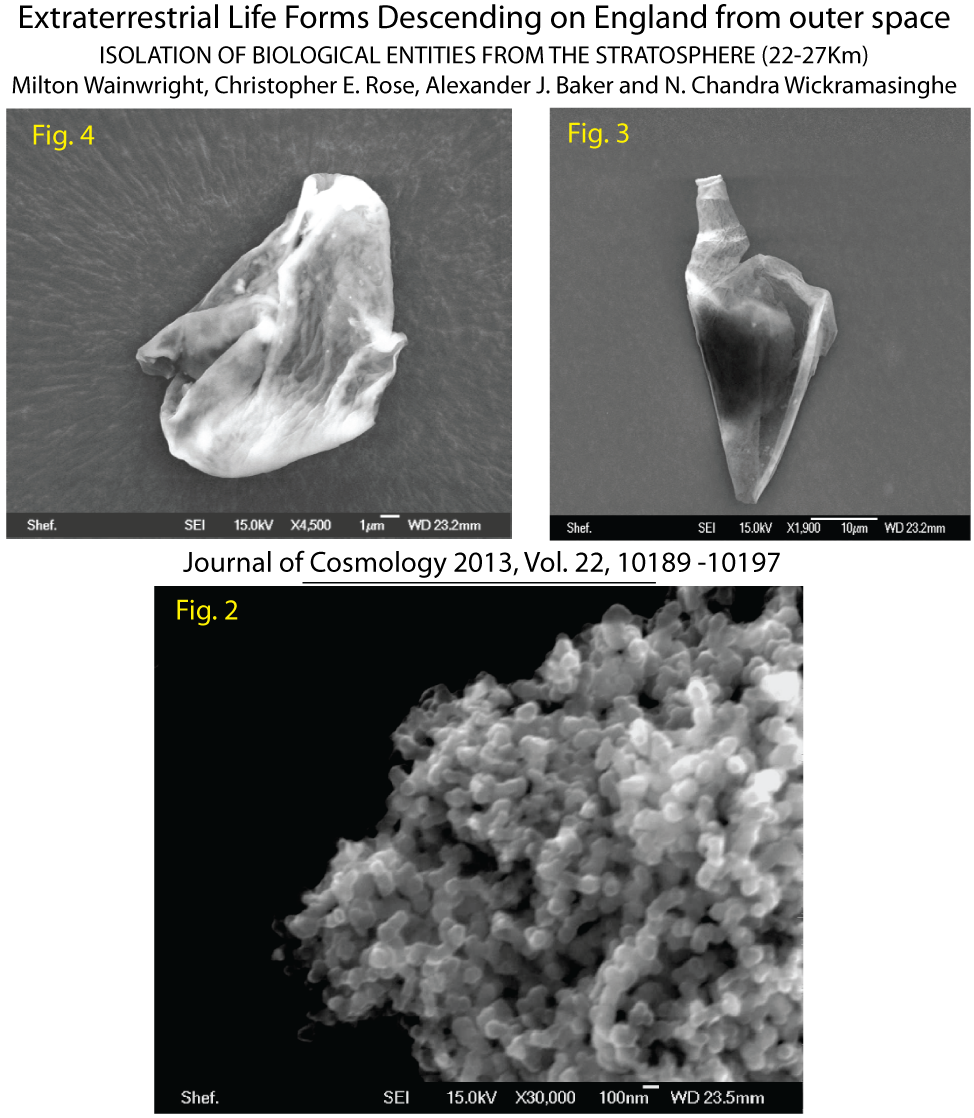
15. Allen Hills and Schopf-like putative fossilized bacteria seen in a new type of carbonaceous meteorite, Milton Wainwright, Christopher E. Rose, Alexander J. Baker, Briston, K.J. and Chandra Wickramasinghe, pp 10198-10205, Ubiquity Press version.
16. Filamentous Biological Entities Obtained from the Stratosphere, Milton Wainwright, Christopher E. Rose, Alexander J. Baker and N. Chandra Wickramasinghe, pp 10206-10211, Ubiquity Press version of this paper, with doi index.
17. Microspherules and Presumptive Biological Entities Found Inside the Polonnaruwa Meteorite, Milton Wainwright, Christopher E. Rose, Alexander J. Baker and N. Chandra Wickramasinghe, pp 10212-10218, Ubiquity Press version.
18. 2013 – Life is a Cosmic Phenomenon : The “Search for Water " evolves into the “Search for Life", William E. Smith, 10219-10246
19. New Cosmology Requires Life on Cosmic Scales, Carl H. Gibson, Conference 8865: Instruments, Methods, and Missions for Astrobiology XVI, Aug. 27, 2013, San Diego, CA, USA, 10247-10266, Carl H. Gibson slides presented, pp 10275-10302
20. MORE BIOLOGICAL ENTITIES FROM THE STRATOSPHERE INCLUDING A DIATOM FRAGMENT-FURTHER EVIDENCE FOR A SPACE ORIGIN, Milton Wainwright, Christopher E. Rose, Alexander J. Baker and N. Chandra Wickramasinghe, 10267-10274, Ubiquity Press version (includes doi index).
See:
where the censorship methods of the "establishment" (LCDMHC) are on full display. No scientific arguments or observations are presented by the anonomous "scientists" against the strong evidence of Hoyle-Wickramasinge cometary panspermia provided by the clever and inexpensive balloon experiments of Professor Wainwright. Instead, the Journal of Cosmology is attacked as "controversial" for publishing such articles that contradict, and indeed completely falsify, LCDMHC cosmology (CHG).
See also:
https://www.independent.co.uk/news/science/the-truth-is-out-there-british-scientists-claim-to-have-found-proof-of-alien-life-8826690.html
which has more pictures.
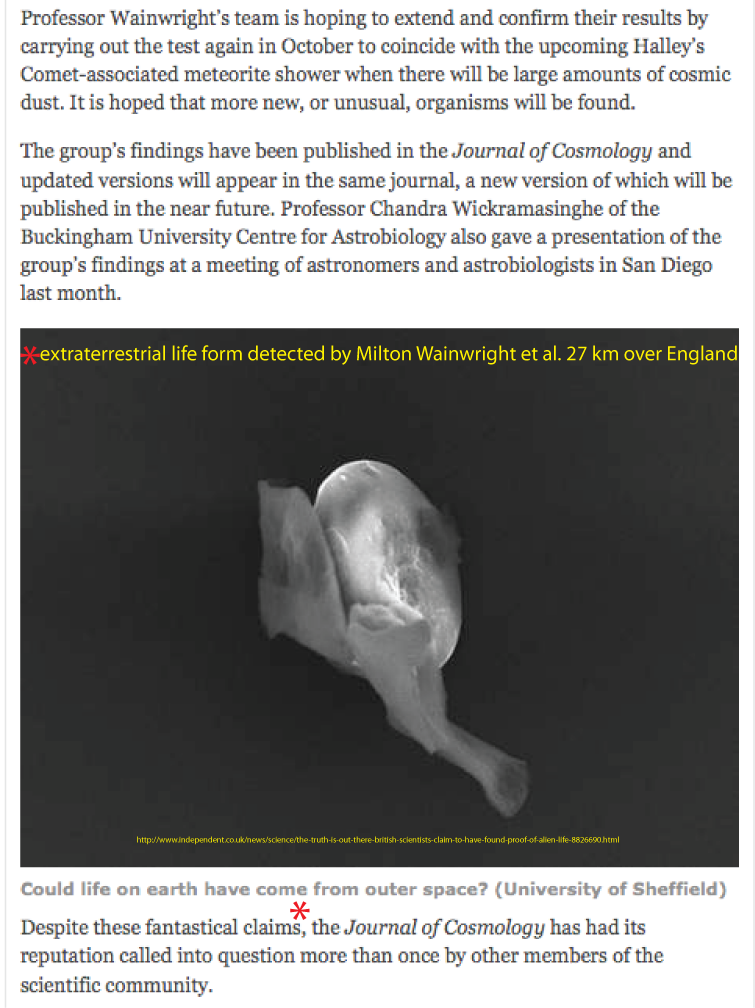
III. ASTRO-THEOLOGY
21. Postmodern Astro-Theology, Cometary Panspermia, and the Polonnaruwa Meteorite: Derham, Wesley, Whitehead, Griffin and Cobb, Theodore Walker Jr., pp 10141-10151
22. Spontaneous Creation of the Universe Ex Nihilo, Maya Lincoln and Avi Wasser, pp 10347-10354
IV. ANNOUNCEMENTS
Plan to partner with Ubiquity Press, LTD, UK, https://www.ubiquitypress.com. Both the Journal of Cosmology and Ubiquity Press favor an open access model, free to the user.
Example article, as prepared by ]u[P from a J of C source file. THE IMPERATIVES OF COSMIC BIOLOGY, Carl H. Gibson, N. Chandra Wickramasinghe, Journal of Cosmology 2010, Vol. 5, 1101-1020, pp 10275-10285
The CEO of ]u[P is Brian Hole: https://brianhole.com/publications/index.html is Brian Hole's publication list.
V. HARVARD WORKSHOP ON SELF INTERACTING (COLD) DARK MATTER AUG 2013
Harvard Self Interacting Dark Matter Workshop, Aug. 7-9, 2013, tries to understand remarkable departures of observations from predictions of LCDMHC cosmology.
The opening speaker was Michael Boylan-Kolchin (Maryland), formerly at the University of California, Irvine. One of his recent preprints is "The Milky Way's bright satellites as an apparent failure of LambdaCDM". Self Interacting (nonbaryonic) Dark Matter is an oxymoron. If galactic (NB) dark matter is relatively collisionless compared to baryons, it will diffuse away from galaxies to form galaxy cluster halos, as shown by HGD cosmology. The evidence for SI(NB)DM is very weak. The concept has no physical basis, as shown in a preprint by Matthew G. Walker. The SIDM of galaxies is mostly baryonic, consisting of 10^36 kg PGC clumps of earth-mass gas planets, as observed by Schild (1996) and predicted from fluid mechanics by Gibson (1996). The dSph galaxies of the Milky Way became collisionless when their planets froze, and diffused outwards from the protogalaxy, as shown in the frontisepiece of Volume 18 of the Journal of Cosmology, not inwards as claimed by LCDMHC (CHG).
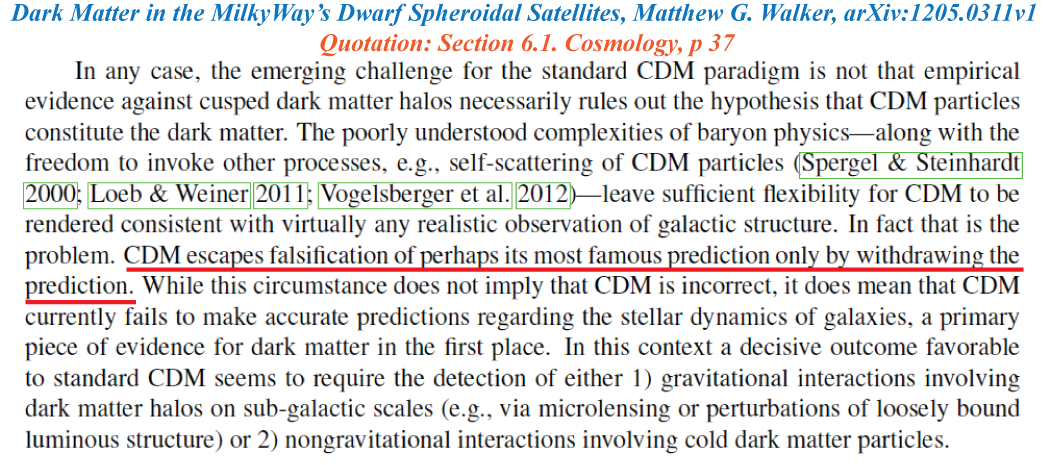
In his excellent review of dSph observations, Walker notes that the most dim dSphs are the most interesting. This is because they are PGCs (proto-globular-star-clusters) according to the HGD cosmology of Gibson (1996) and Schild (1996); that is, dense clumps of frozen gas planets that comprise the dark matter of galaxies. See his Figure 17:
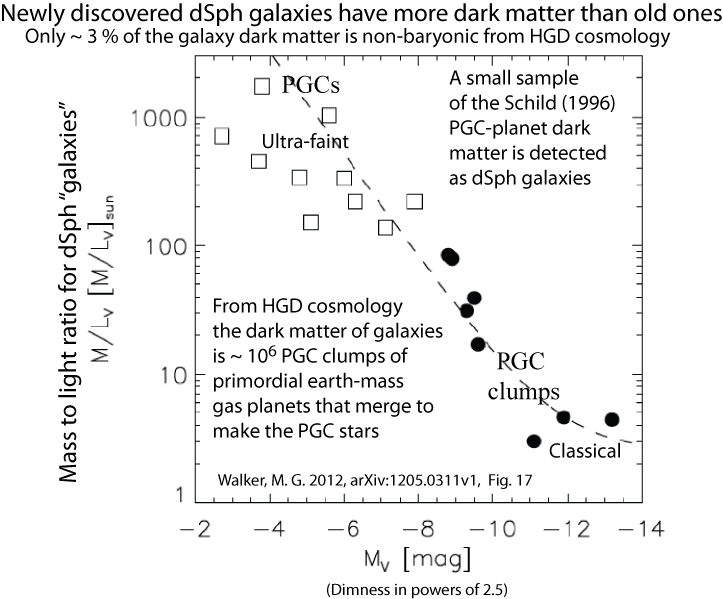
which shows the Ultra-faint dSph (dwarf spherical) galaxies have mass to light ratios that exceed 1000, as HGD cosmology predicts for PGCs with few stars. This is also shown in Walker's Figure 13:
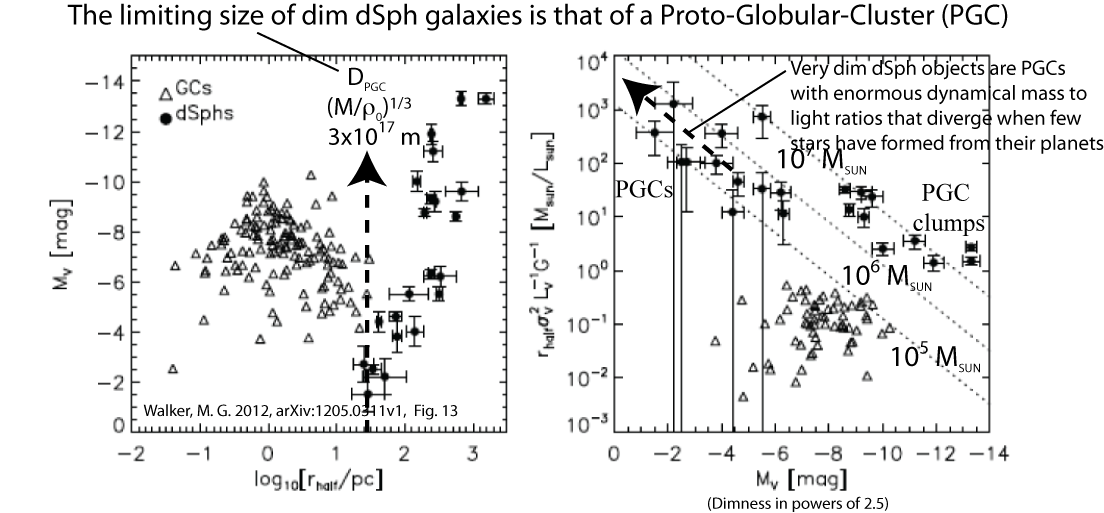
where the limiting size of globular-star-clusters (GCs) matches the size of PGCs (3x10^17 meters) on the left. The divergence of the dynamical mass to light ratio shown on the right of the figure is expected for dim PGCs with few stars formed by planet mergers.
More globular-star-clusters appear in superclusters like Abell 1689 than in the Milky Way, as shown by Alamo-Martinez et al. (2013). The GCs and the PGCs retain the same mass density as the supercluster at the time of its viscous-gravitational fragmentation during the plasma epoch at 10^12 seconds (30,000 years), as shown in the following figure. Note that the initial plasma proto-supercluster and gas proto-galaxy sizes ~ 10^20 m (yellow dot) are too small to be shown. The initial plasma density ~ 4x10^-17 kg m^-3 is retained by the PGC clumps of planets and the GCs as a fossil of the plasma fragmentation. The homogeneous spherical-symmetry of the GCs in the Abell 1689 supercluster falsifies the fundamental LCDMHC mechanism of hierarchical clustering, which should produce inhomogeneous, asymmetrical, GC distributions on supercluster scales (CHG).
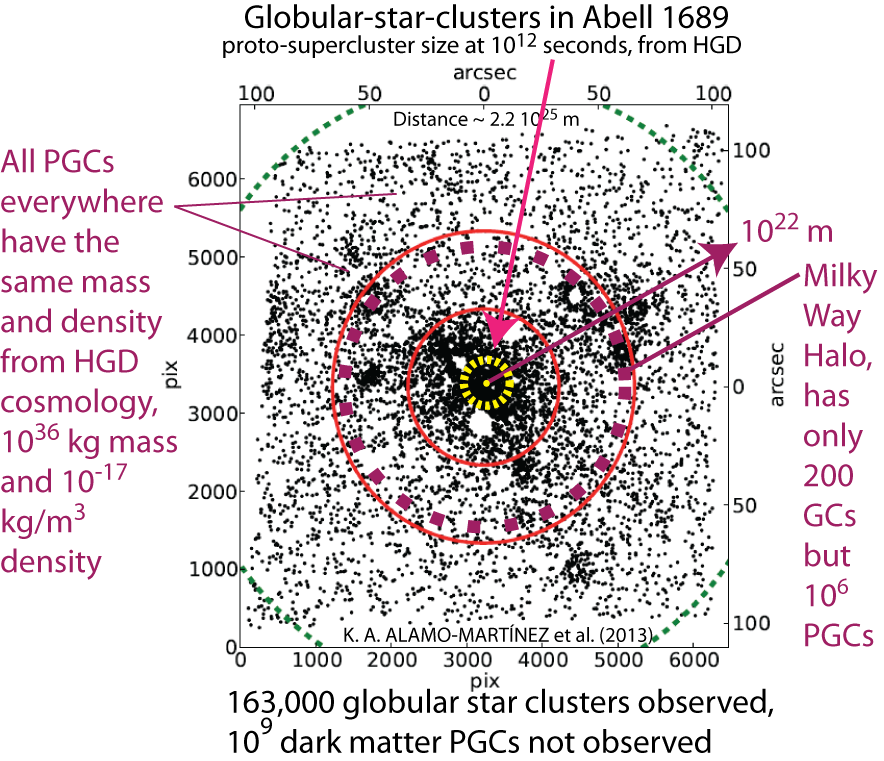
The inspiration for much of the work on Self-Interacting-Cold-Dark-Matter is the arXiv preprint of Spergel and Steinhardt (1999). Note that the terminology SIDM is propaganda bafflegab invented to lock in the erroneous LCDMHC concept that galactic dark matter is mostly nonbaryonic. It is not. From HGD cosmology, the galaxy dark matter is about 97% dark matter planets in Jeans mass clumps (PGCs), as observed.
Many of the talks can be found at https://users.physics.harvard.edu/~mreece/HarvardSIDM2013/ eg:
Boylan-Kolchin: The end of the road for LCDMHC? , The Milky Way's bright satellites as an apparent failure of LCDM, Michael Boylan-Kolchin, James S. Bullock and Manoj Kaplinghat, "We use the Aquarius simulations to show that the most massive subhalos in galaxy-mass dark matter halos in LCDM are grossly inconsistent with the dynamics of the brightest Milky Way dwarf spheroidal galaxies. ...", Presentation, pp 10247-10310
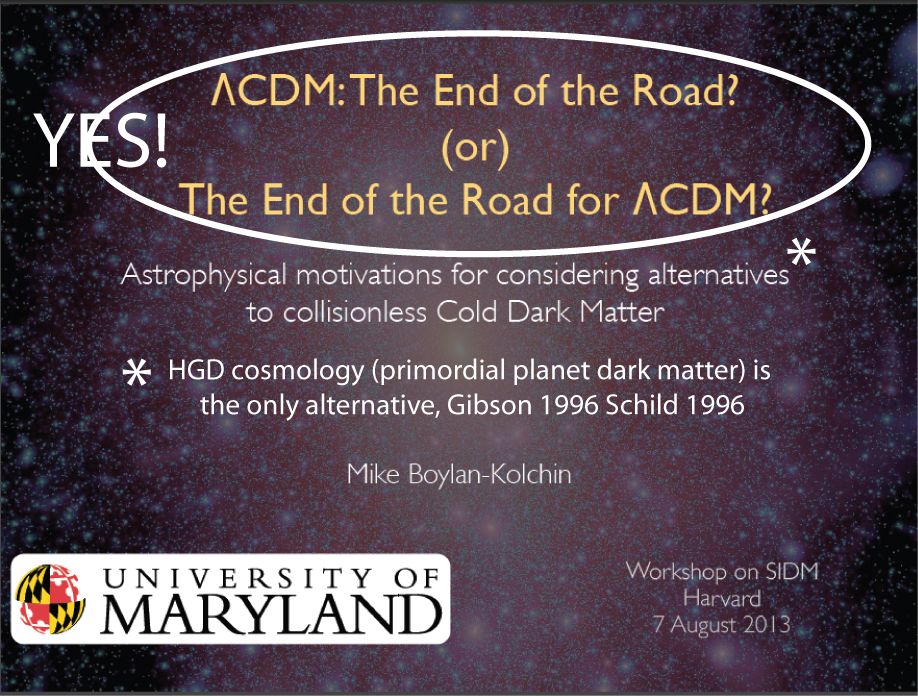
Bullock: Solving Too Big to Fail: Baryonic or Dark Matter Physics?, pp 10311-10346
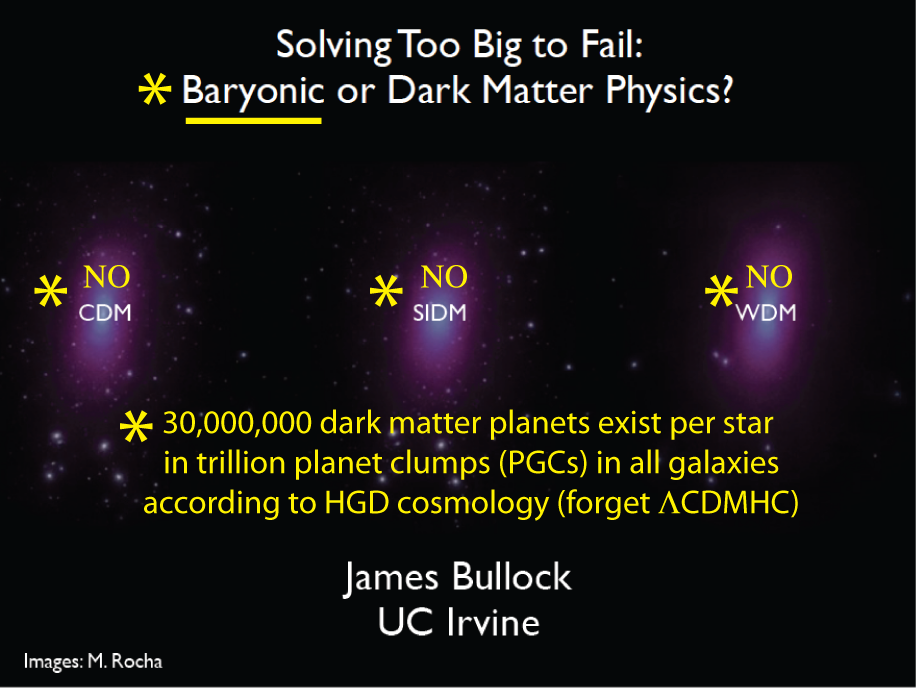
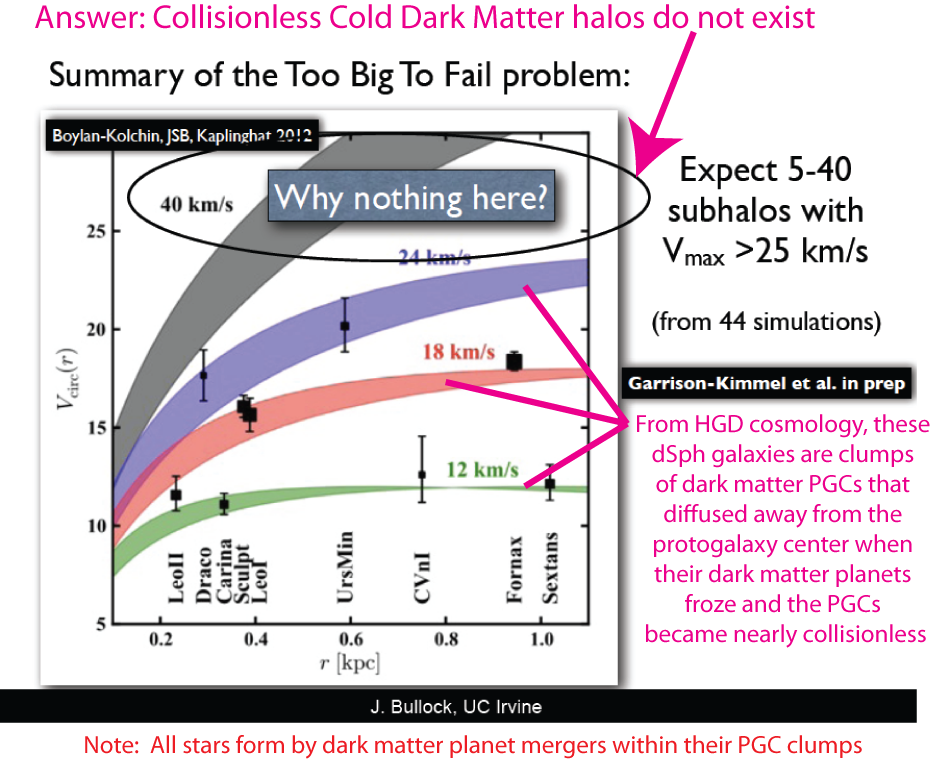
Rocha: Solving Too Big to Fail: Baryonic or Dark Matter Physics?, pp 10355-10451
Brooks: Baryons matter: Interpreting our Cosmological Model, pp 10452-10476
Hai-Bo Yu: Beyond Collisionless Dark Matter: From a Particle Physics Perspective, pp 10477-10511
Tulin: Direct Detection of SIDM, pp 10512-10547, raises questions about two colliding (NOT merging) galaxy clusters called the bullet cluster 1E065757-58. The relative velocity of the collision is large, 4.5 10^6 m/s (actual bullets move ~10^-4 slower), at redshift z=0.3 when clusters were smaller than present galaxies, such as the Milky Way with halo size ~ 10^22 m (yellow dashes). Very hot gas (80 million K) detected by the x-ray telescope Chandra shows that the self interaction of galaxy dark matter can easily be explained as viscous friction of the PGC fluid, leaving hot wakes behind the cluster centers. Nonbaryonic dark matter halos have diffused to scales > 10^23 m from HGD cosmology. Note the halo of weakly interacting PGC "fluid particles" diffused to > 10^22 m from the cluster centers because their dark matter planets are frozen solid and nearly collisionless. Compare to Abell 1689 above (green dashes).
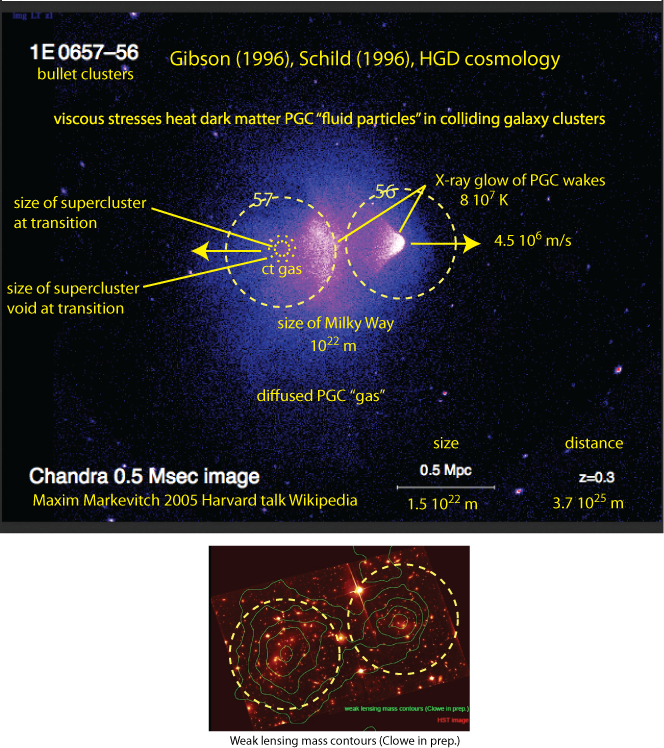
So we see evidence in the bullet cluster that the self-interacting dark-matter is weakly-collisional PGC clumps of dark matter planets. These have diffused as a gas from the protosuperclusters emerging from the plasma epoch at 300,000 years. At this plasma-gas transition, reduced viscosity fragmented dark-matter earth-mass planets detected by Schild (1996) in the Jeans mass PGC clumps predicted by Gibson (1996) from fluid mechanics. Supercluster voids first appear at 30,000 years by photon-viscous fragmentation of the plasma, and are always larger than superclusters, according to HGD cosmology, as shown. From LCDMHC cosmology, superclusters and their voids appear last, rather than first. Voids larger than 10^25 m have been observed, and falsify all LCDMHC cosmology scenarios.
Zavala-Franco: Dark Matter Distribution In Galactic SIDM Halos, pp 10548-10568
Note: According to Hydro-Gravitational-Dynamics (HGD) cosmology (Gibson 1996, Schild 1996) the nearly collisionless "Cold Dark Matter" diffuses away from the collisional baryonic dark matter during the plasma epoch (<10^13 seconds) when protosupercluster objects like Abell 1689 are fragmented (see Figure above), controlled by photon-viscosity forces and gravity. Protogalaxies are the smallest plasma objects at transition to gas, and fragment into dark matter planets in Jeans mass clumps of a trillion planets, termed Proto-Globular-Star-Clusters (PGCs). When the planets freeze the PGCs diffuse to form the nearly homogeneous pattern of GCs shown. The planets of the PGCs are in meta-stable equilibrium, permitting viscous interactions of PGCs as they diffuse from the protogalaxy core. Nonbaryonic dark matter and the mythological "CDM" have nothing to do with the patterns observed. Following is a quote from Schild (1996) where he suggests that planets comprise the dark matter of galaxies, confirming the hydrodynamic predictions of Gibson (1996) (CHG).
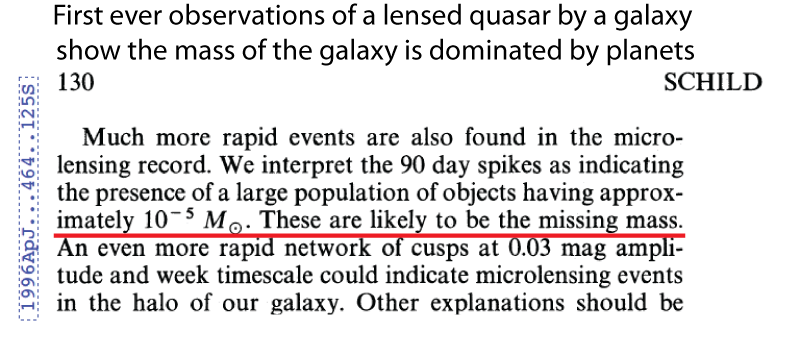
This proposal by Schild (1996) has been repeatedly confirmed and refined by subsequent observations of the same and other lensed quasars. Evidence that extremely hot hydrogen gas planets, stars, and supernovae existed ~ 10^12 seconds after the plasma to gas transition at ~ 10^13 seconds is provided by condritic meteorites.
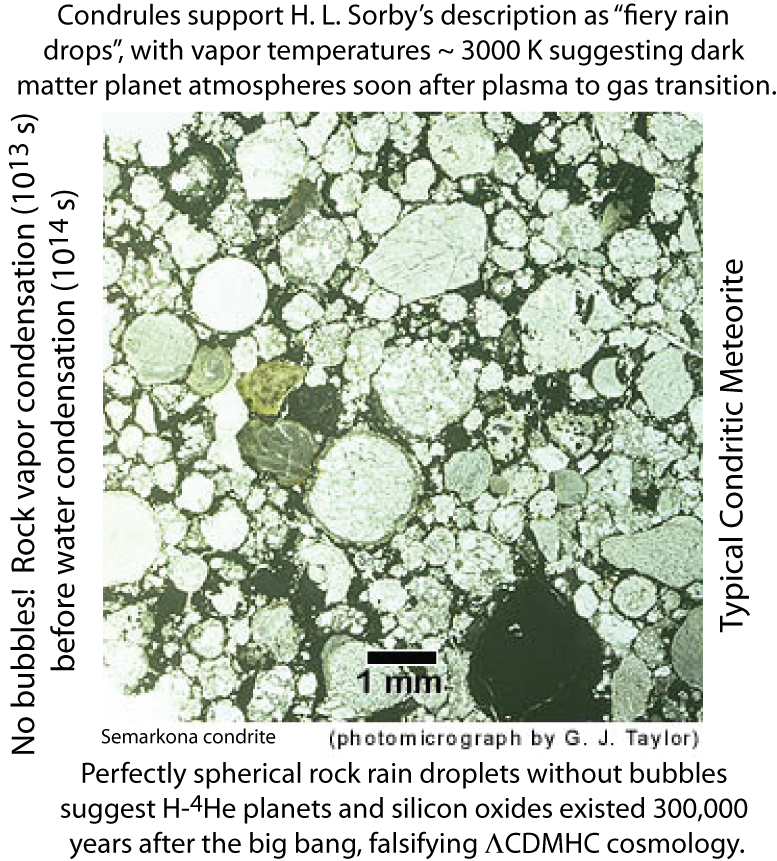
None of the condrules contain gas bubbles, proving their extraterrestrial formation. Terrestrial rocks all have mm water bubbles. These fiery rock rain-drops of H. L. Sorby (1877) are much too large to have been ejected by stars or supernovae (which make mm olivine dust). Their formation requires the 3000 K atmospheres of hot dark-matter hydrogen planets (0.3 Myr) just before the condensation of water at 647 K (2 Myr). First stars and first supernovae (0.3 Myr + 0.03 Myr) are required by these planets in clumps (CHG). See SPIE 2013 astro-biology conference preprint of contribution 8865-27 on the evidence for primordial dark-matter planets, and their key role in the formation of comets, the first stars, supernovae, and life, beginning not at 300 Myr but 0.3 Myr. The timeline for condrule formation strongly favors a biological big bang starting about 2 million years after the cosmological big bang, ruling out any extended Dark Ages time period.
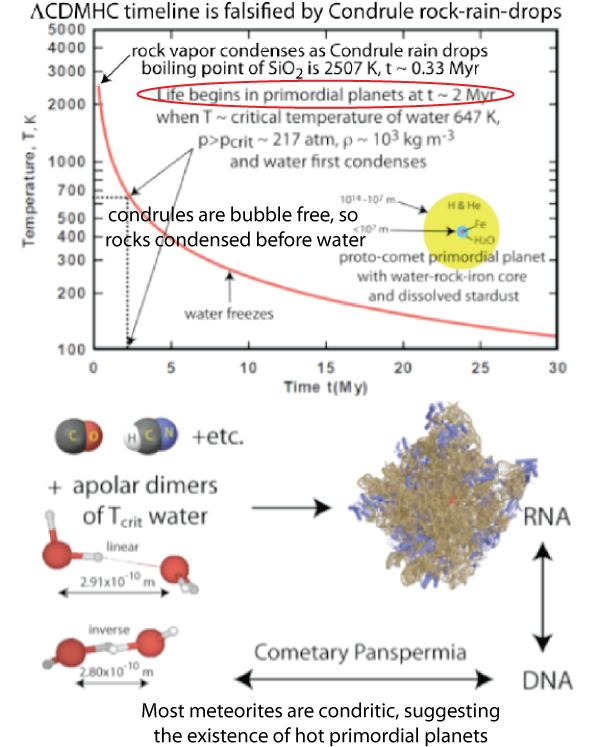
Sri Lanka meteorite compared to a rocky meteorite (Semarkona condrite) containing condrules:
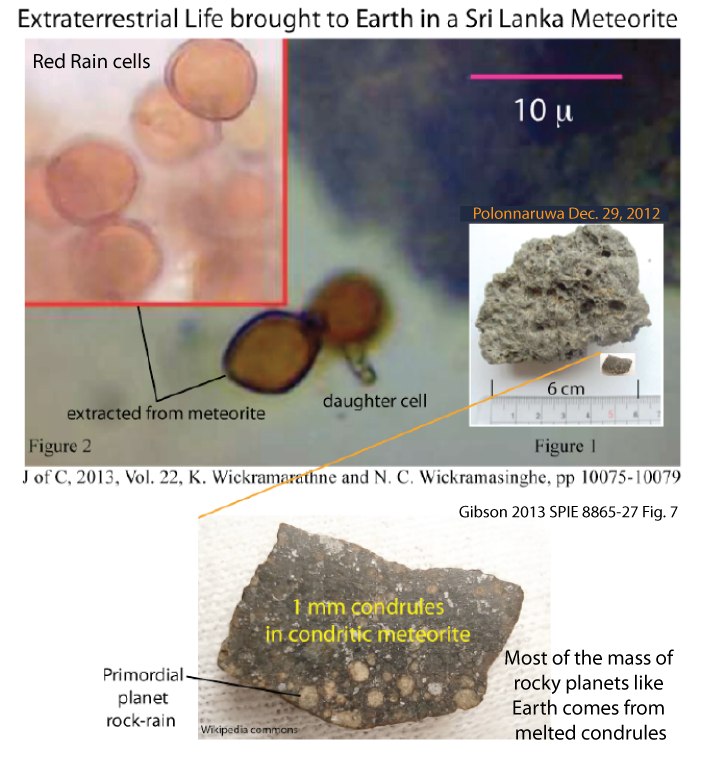
The infrared space telescopes Herschel and Planck show images of the PGC clumps of dark matter planets detected by Schild (1996) and predicted by Gibson (1996). The most massive clumps of PGCs in the Milky Way are the small and large Magellanic star clouds, which both have halo clouds of PGCs at their boundaries. The SMC PGC cloud is shown below. A similar LMC PGC halo cloud also exists.
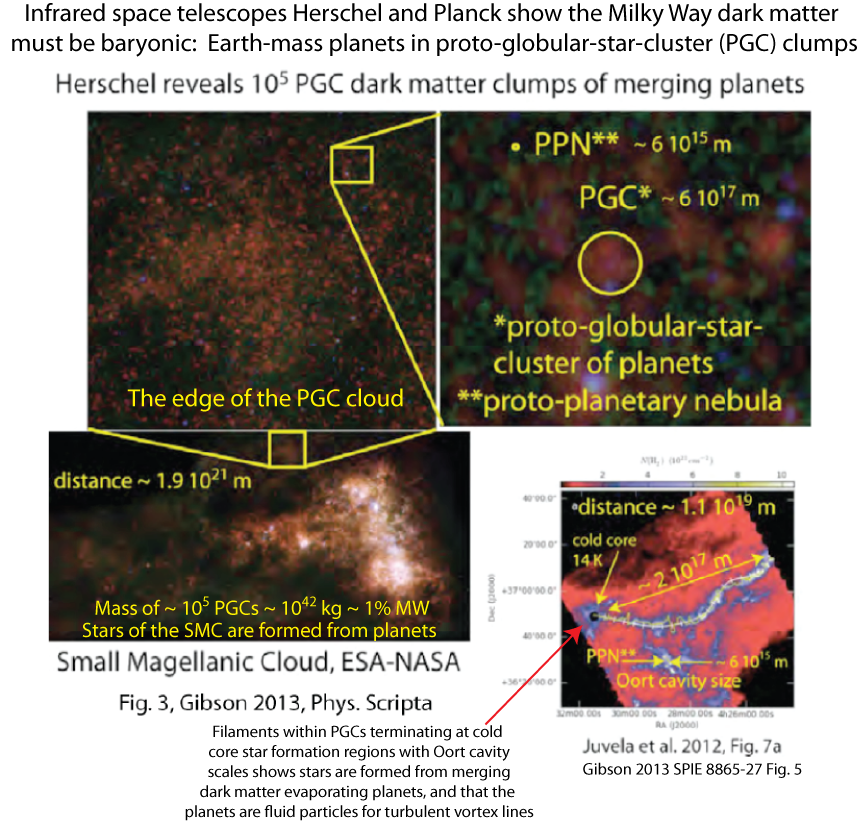
It is clear from the Harvard SIDM presentations and referenced papers that strong pressures exist to conform to the standard LCDMHC cosmological model, just as Hoyle and Wickramasinghe were pressured by Editors and Referees to conform to the terrestrial abiogenesis model for decades of their efforts to develop astro-biology. The result is censorship of new scientific ideas. See:
23. EXTRATERRESTRIAL LIFE AND CENSORSHIP, N. Chandra Wickramasinghe, pp 10247-10263
Both the arXiv and Wikipedia have adopted procedures that effectively censor nonestablishment ideas such as HGD cosmology, turbulence defined by inertial vortex forces that always cascades from small scales to large, fossil turbulence, MECOs rather than black holes, and all evidence of extraterrestrial life (CHG).
24. Transfer of Life-Bearing Meteorites from Earth to Other Planets, (preprint) Tetsuya Hara, Kazuma Takagi, and Daigo Kajiura, pp 10569-10575
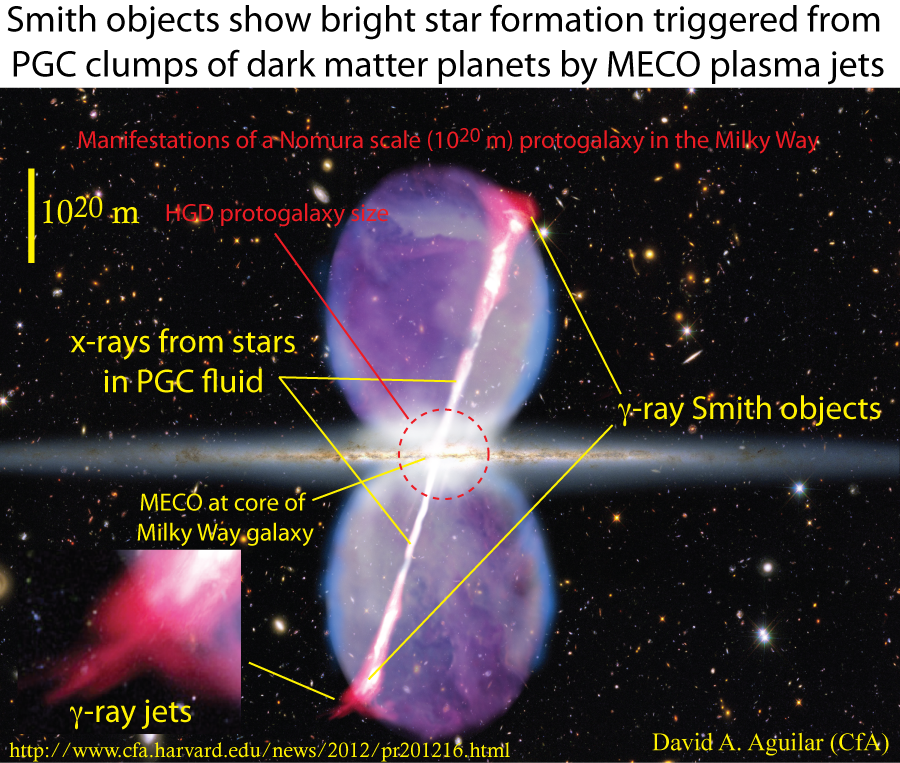
Another example of x-ray and even gamma-ray radiation from the dark matter PGC fluid that dominates the mass of all galaxies is seen in the Milky Way galaxy, as pointed out to CHG by Bill Smith. According to Gibson-Schild (1996) HGD cosmology, all galaxies were fragmented as protogalaxies at the end of the plasma epoch at the Nomura scale of 10^20 meters (slightly larger than the Kolmogorov scale at the time). The clumps of dark matter planets diffuse to form the galaxy halo and an accretion disk. A supermassive MECO (magnetospheric eternally collapsing object) is formed, as described by Schild in several papers, with plasma jets that trigger star formation in the PGC fluid of planet clumps. The present jets of the Milk Way are so weak that they terminate well within the 10^22 m halo, forming Smith objects similar to the Herbig Haro objects formed by evaporating dark matter planets along and at the ends of the plasma jets of young stars. The bubbles formed reflect the 10^20 m Nomura scale size of the original protogalaxy, as shown by the dashed red circle at the center of the MW galaxy (CHG).
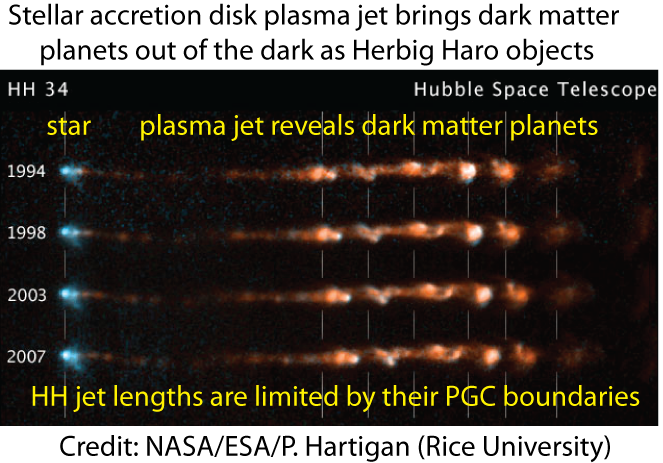
A sequence of HST images of HH objects reveals their motion from 1994 to 2007. The nature of the interstellar medium as frozen dark matter planets greatly simplifies the interpretation. Stellar accretion disks are observed at the Oort cavity (~3x10^15 m) scales expected from a uniform PGC density and HGD cosmology. An intermittent random rate of HH object ejection is observed that is mysterious if the interstellar medium is gas and dust, but just what one would expect if the material feeding the jet is frozen hydrogen dark matter planets.
24.1. Editorial Comments (Carl H. Gibson), "Plasma Jets reveal the dark matter of galaxies as frozen gas planets in clumps", pp 10578-10585
24.3 Editorial Comments (Carl H. Gibson), Preprint (Ade et al.) Planck 2013 results. XVI. Cosmological parameters, pp 10586-10653
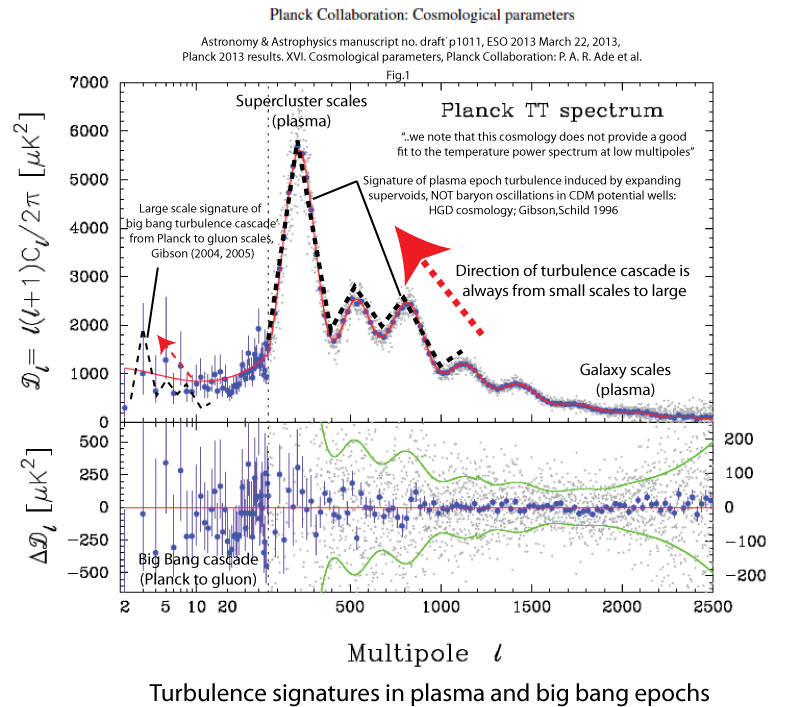
Editorial Illustration (Carl H. Gibson), Planck spectrum turbulence patterns, p 10695
24.2 Editorial Comment (Carl H. Gibson), "Planck spectrum shows evidence of big bang and plasma epoch turbulence", pp 10654-10660
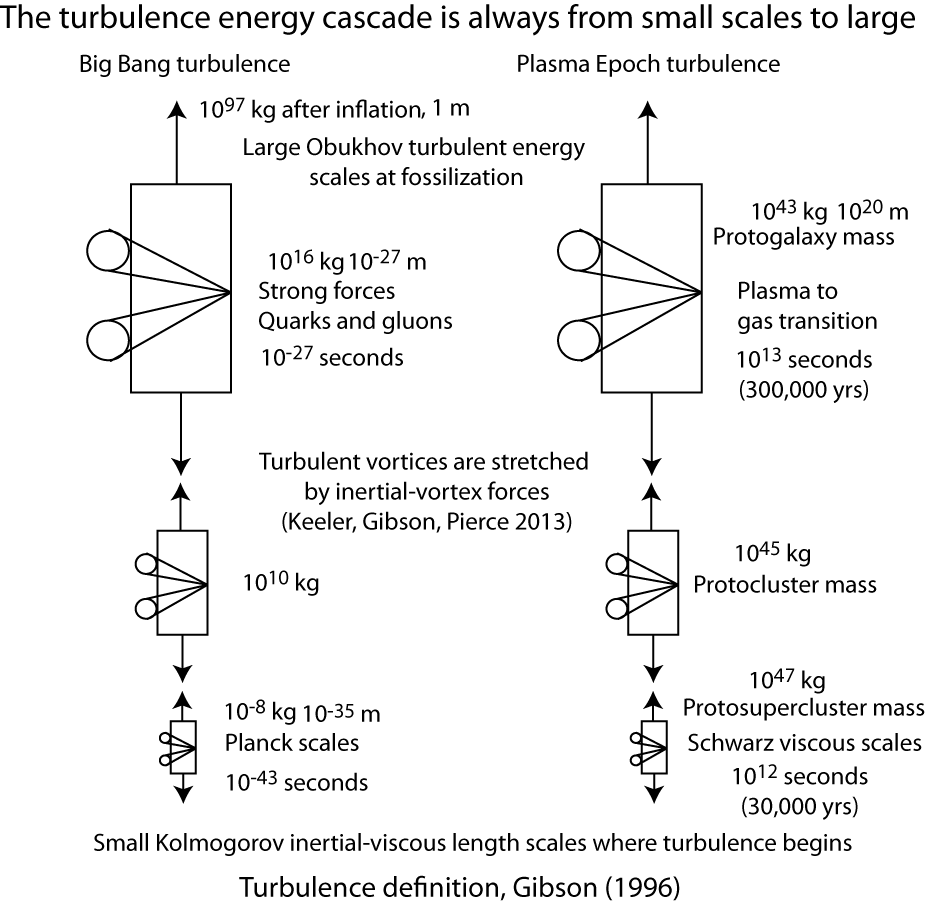
Illustration, Big bang turbulence and plasma epoch turbulence scales, p10696
VI. AMERICAN PHYSICAL SOCIETY / DIVISION OF FLUID DYNAMICS PITTSBURG MEETING: SELECTED PAPERS ON TURBULENCE
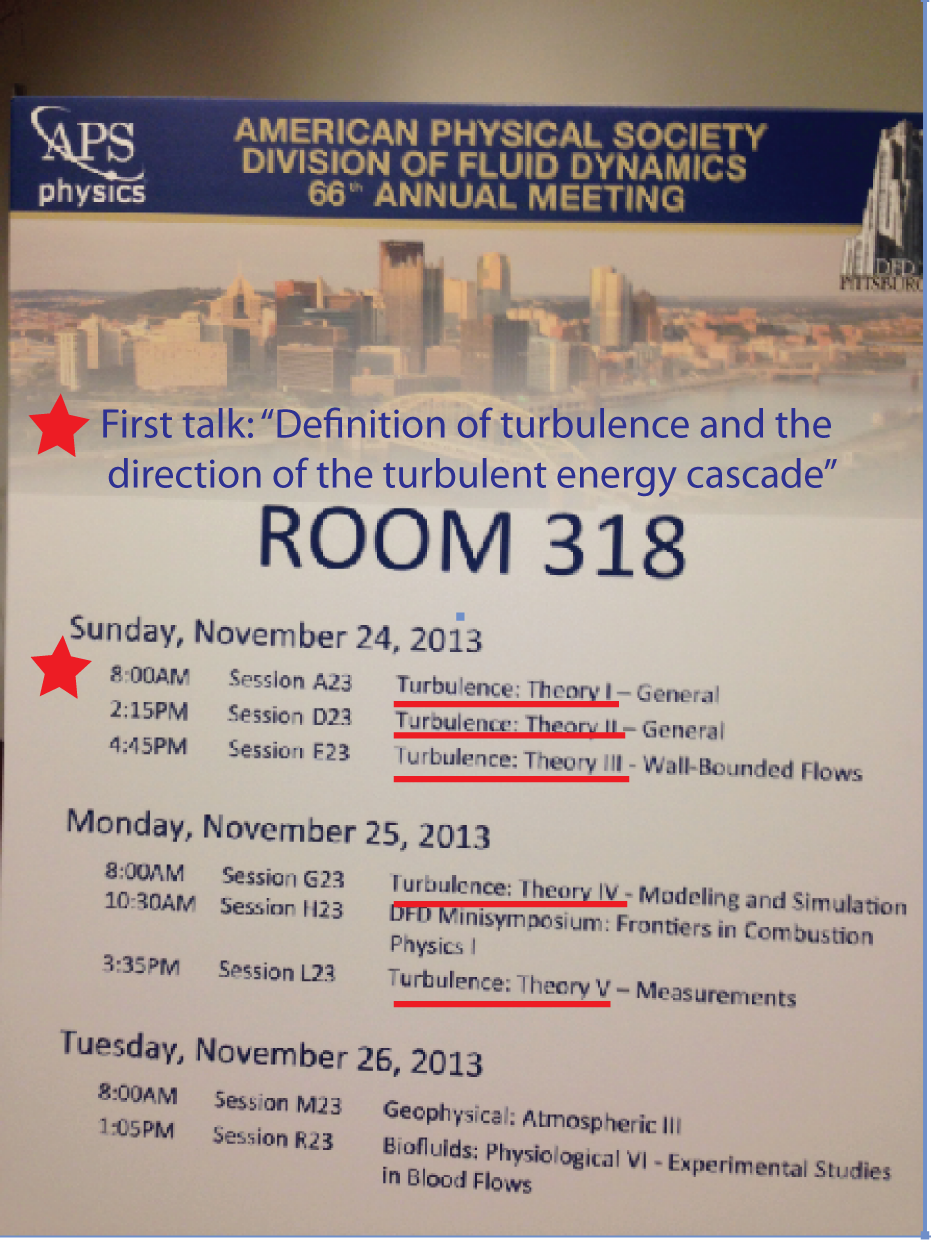
24.3 Presentation, Carl H. Gibson, "The Definition of Turbulence and the Direction of the Turbulent Kinetic Energy Cascade", Session A23 1, Nov. 24, 2013. Pdf version, pp 10661-10678
Describes a big bang turbulence model. The inertial vortex forces vxw that define turbulence produce the CMB signatures detected by Planck and WMAP space telescopes. Clearly the cascade direction of big bang turbulence must be from small scales (the Planck scale ~ 10^-35 m) to large (the quark scale ~ 10^-27 m) where it is fossilized by inflating outside the horizon scale ct. How exactly does turbulence begin? Professor Leonard uses the Johns Hopkins University repository of forced direct numerical simulations of turbulence to show it begins on intense vortex structures stretched by vxw structures with patterns that match those of the CMB Planck and WMAP images. See Illustrations (p 10695 and p 10696) for the Planck spectrum (CHG).
Presentation, Anthony Leonard, "On intense vortex structures in isotropic turbulence", Session G23 1, Nov. 25, 2013. Up-dated Dec. 19, 2013, pp 10680-10693
Shows extremely concentrated vortex structures exist at the Kolmogorov scale with ~ 6.5 aspect ratio and anisotropies in direct numerical simulations of turbulence, consistent with the Gibson (2004, 2005) big bang turbulence model, cascade direction, and turbulence definition. The Taylor microscale Reynolds number of the simulation (Re_lambda = 433) approximates that estimated for big bang turbulence (Re_lambda ~ 1000). The anisotropies of the simulated vortex structures support those in the p 10695 and p 10696 illustrations (CHG).
Presentation, Luminita Danaila and Laurent Mydlarski, "Transfer of passive scalar variance in decaying grid turbulence with a mean scalar gradient", Session G22 3, Nov. 25, 2013 (pptx).
An attempt to describe "turbulent" mixing of scalar and velocity varience from large to small scales without reference to the vxw definition of turbulence and the turbulence cascade, which is always from small scales to large.
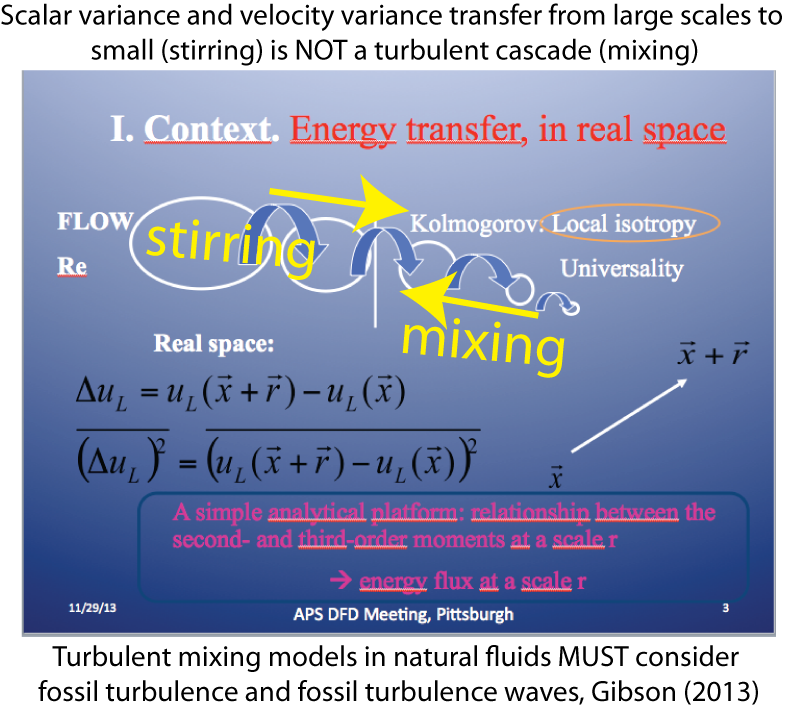
Turbulent mixing modeling in natural fluids like the ocean and atmosphere that do not include the vxw definition and cascade direction are in the same danger of inconsistencies and falsification as the "standard" models of cosmology, astrophysics, and astronomy.
Presentation, Michael Gauding and Norbert Peters, "Statistical investigation of turbulent mixing by means of turbulent line segments", Session 22 5, Nov. 25, 2013 (pdf).
Direct numerical simulation of turbulent mixing. The results support the Gibson (1968ab) theory of universal similarity of minimal and maximal scalar gradient points advected by vxw (Kolmogorovian) turbulence. The scalar extrema diffuse to positions of symmetry and split along directions of extreme stretching at Batchelor scales for all molecular diffusivities according to the Gibson (1968ab) theory, contrary to Batchelor-Howells-Townsend (1959). See the "great power laws on the sky" pulsar beam scattering data shown as the Frontispiece of Volume 21 (CHG).
25. Cosmic and Electrical Stress Model Calculation, Dan H. Holland, pp 10694-10701